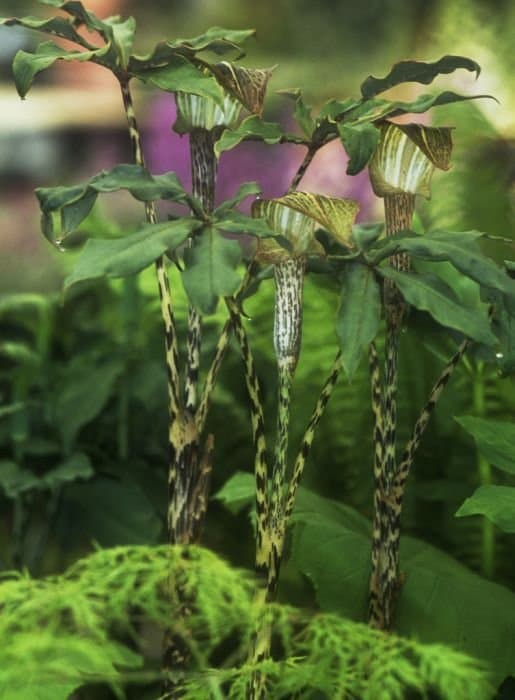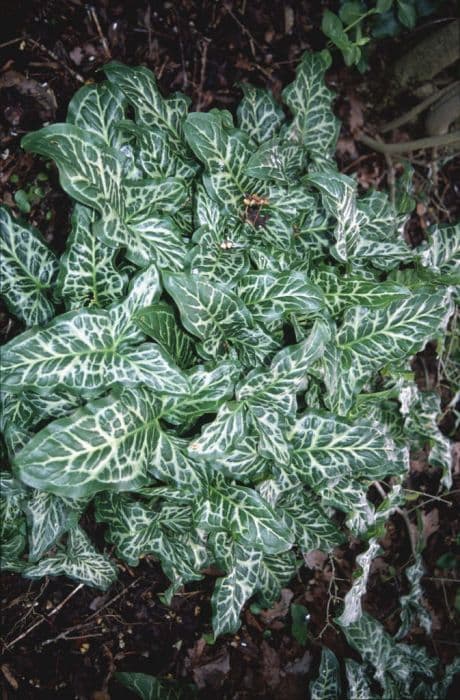Calla Lily 'Snow Storm' Zantedeschia 'Snow Storm' (PBR)

ABOUT
The Zantedeschia 'Snow Storm', commonly known as the Calla Lily 'Snow Storm', is striking with its elegant and showy flowers. The blossoms are characterized by a large, funnel-shaped white spathes that resemble a rolled sheet and are beautifully contrasted by a yellow finger-like spadix at their center. The spathes have a pristine white hue that can appear to glow, lending an almost ethereal quality to the bloom. This plant produces lush green leaves that are arrow-shaped with a glossy finish, which may sometimes have white spots or markings, adding to the variegated appearance of the foliage. The leaves provide a verdant backdrop for the dramatic flowers, making the 'Snow Storm' variety a popular choice for ornamental display. The flowers and foliage together create a striking visual display, evoking a sense of elegance and purity.
About this plant
 Names
NamesFamily
Araceae
Synonyms
Calla Lily, Arum Lily.
Common names
Zantedeschia 'Snow Storm' (PBR)
 Toxicity
ToxicityTo humans
The plant commonly known as calla lily is toxic to humans. If ingested, any part of the plant can cause symptoms such as oral irritation, burning sensation in the mouth and throat, difficulty swallowing, and nausea. In severe cases, vomiting and diarrhea may also occur. Handling the plant may sometimes cause skin irritation due to the presence of calcium oxalate crystals.
To pets
Calla lily is poisonous to pets such as cats and dogs. If a pet ingests any part of the plant, they may exhibit symptoms including oral irritation, excessive drooling, vomiting, and difficulty swallowing. In severe cases, ingestion could lead to dehydration and renal failure due to the presence of insoluble calcium oxalate crystals. Immediate veterinary attention is recommended if a pet consumes calla lily.
 Characteristics
CharacteristicsLife cycle
Perennials
Foliage type
Deciduous
Color of leaves
Green
Flower color
White
Height
2 feet [60 cm]
Spread
1 foot [30 cm]
Plant type
Herb
Hardiness zones
9
Native area
South Africa
Benefits
 General Benefits
General Benefits- Attractive Flowers: Produces large, showy white spathes that resemble flowers, adding visual interest to gardens or indoor spaces.
- Long Blooming Season: Offers a generous blooming period that extends through multiple seasons, depending on the climate.
- Easy to Grow: Relatively low maintenance and can thrive with basic care, making it suitable for gardeners of all skill levels.
- Versatility: Can be grown both outdoors in gardens or borders and indoors as a potted plant, giving it versatility in use.
- Event Decor: Ideal for use in weddings and other events due to its elegant and striking appearance.
- Themed Gardens: Perfect for adding to white-themed gardens or moon gardens where its bright flowers can shine during the twilight hours.
- Drought Tolerance: Once established, it exhibits a degree of drought tolerance, reducing the need for frequent watering.
- Attracts Wildlife: Can attract beneficial pollinators like bees and butterflies to the garden, supporting local ecosystems.
 Medical Properties
Medical PropertiesThis plant is not used for medical purposes.
 Air-purifying Qualities
Air-purifying QualitiesThis plant is not specifically known for air purifying qualities.
 Other Uses
Other Uses- Calla Lily 'Snow Storm' can be used in printmaking crafts, where the sturdy leaves can be coated with paint and pressed onto paper to create botanical prints.
- In the Victorian language of flowers, giving a Calla Lily 'Snow Storm' may symbolize magnificence and beauty, making it an unusual but thoughtful gift for art and antique enthusiasts.
- These plants can be used in photography as a subject for practicing high-key lighting techniques due to their bright white blooms and contrasting dark foliage.
- The strong stems of Calla Lily 'Snow Storm' make them suitable for use in lightweight plant-based structures, such as trellises for other plants.
- They can be utilized in edible flower arrangements, though with considerable caution as all parts are poisonous if not properly prepared or mistaken for edible species.
- Calla Lily 'Snow Storm' can be planted near reflective surfaces in gardens to play with light and shadow for dynamic landscape designs.
- They can be used in artistic dyeing processes, where the pigments from the flowers may provide subtle hues to fabrics or papers.
- Their tall and elegant appearance allows them to be used as natural markers or waypoints in a large garden or during garden tours.
- When dried, the seed pods can be incorporated into homemade potpourri mixes or as decoration in dry flower arrangements.
- Enthusiasts of Feng Shui might use Calla Lily 'Snow Storm' to symbolize purity and peace when placed appropriately within the home or workspace.
Interesting Facts
 Feng Shui
Feng ShuiThe Calla Lily is not used in Feng Shui practice.
 Zodiac Sign Compitability
Zodiac Sign CompitabilityThe Calla Lily is not used in astrology practice.
 Plant Symbolism
Plant Symbolism- Purity & Innocence: The white color of Calla Lily 'Snow Storm' signifies purity and innocence, making it a popular choice in bridal bouquets and at weddings.
- Beauty & Elegance: With its graceful form, the Calla Lily is often associated with beauty and elegance, representing refined beauty and sophistication.
- Rebirth & Resurrection: Because Calla Lilies bloom in the spring, they symbolize rebirth and resurrection, often linked to Easter and new beginnings.
- Overcoming Challenges: The robust nature of the Calla Lily, able to grow in various conditions, stands for the ability to overcome challenges and flourish despite adversity.
- Devotion & Faithfulness: As a perennial, the Calla Lily 'Snow Storm' returns every year, representing devotion and faithfulness in relationships and matrimonial fidelity.
 Water
WaterFor the Calla Lily 'Snow Storm', the watering needs are moderate. Aim to keep the soil consistently moist, but not soggy. During active growth in spring and summer, water thoroughly once the top inch of soil feels dry to the touch, which might be once or twice a week, depending on climate conditions. Each watering session should provide enough water to soak the root zone; for a potted plant, this might be around 16-24 oz of water. It's vital to reduce watering frequency in the winter when the plant is not actively growing, perhaps to once every couple of weeks, depending on the dryness of the indoor air.
 Light
LightThe Calla Lily 'Snow Storm' thrives best in bright, indirect sunlight. An ideal spot would be near a window that receives plenty of light but is shielded from the harsh afternoon sun. They can tolerate some direct sunlight, especially in the morning, but should be protected from strong, direct sunlight during peak hours to prevent leaf scorch.
 Temperature
TemperatureCalla Lilies 'Snow Storm' prefer temperatures between 60 and 75°F for optimal growth. They can endure temperatures as low as 50°F but should not be exposed to temperatures below that as they are sensitive to cold. In their dormant period during winter, cooler temperatures around 50-55°F are acceptable, but always avoid frost which can be detrimental to the plant.
 Pruning
PruningPruning Calla Lily 'Snow Storm' primarily involves removing spent flowers and yellowing leaves to promote healthy growth and improve the plant's appearance. Cut the dead material at the base without damaging the main stem. Pruning is best done after the blooming season, typically in late summer or fall, when the plant begins to enter its dormant period.
 Cleaning
CleaningAs needed
 Soil
SoilCalla lily 'Snow Storm' thrives best in well-draining, rich soil with a pH between 5.6 and 6.5. A mixture of potting soil, peat moss, and perlite or sand in equal parts is ideal for ensuring proper drainage and fertility. Regularly check the soil acidity, adjusting with lime or sulfur as needed to maintain the optimal pH range.
 Repotting
RepottingCalla lily 'Snow Storm' should be repotted every two years or when it becomes root-bound. The best time for repotting is in the spring or after the blooming period, using fresh soil mix to provide nutrients and encourage growth.
 Humidity & Misting
Humidity & MistingCalla lily 'Snow Storm' prefers a moderate humidity level, ranging between 40% and 60%. To maintain these conditions, especially in drier indoor environments, consider using a humidifier or placing the pot on a tray of wet pebbles to increase the moisture in the air.
 Suitable locations
Suitable locationsIndoor
Place Calla lily 'Snow Storm' in bright, indirect light with moderate humidity.
Outdoor
Plant Calla lily 'Snow Storm' in partial shade, in moist, well-drained soil.
Hardiness zone
8-10 USDA
 Life cycle
Life cycleZantedeschia 'Snow Storm' (PBR), commonly known as Calla Lily 'Snow Storm', starts its life cycle as a rhizome, which is a type of underground stem that stores energy for the plant. The rhizome sprouts into leafy growth that may initially produce only foliage, gathering energy through photosynthesis. In the flowering stage, the plant produces its iconic flowers consisting of a spadix surrounded by a large, often white spathe that can occur in spring or summer depending on the climate and growing conditions. After pollination, typically by insects, the flowers may produce berries containing seeds, although commercial propagation is more commonly through division of rhizomes. As the growing season concludes, the above-ground portion of the plant dies back, and the rhizome enters a dormant period, particularly in cooler climates. With the return of warmer temperatures and growing conditions, the cycle begins anew as the rhizome again sends up shoots, repeating the life cycle.
 Propogation
PropogationPropogation time
Spring-Early Summer
Zantedeschia 'Snow Storm', commonly known as the Calla Lily, can be propagated most effectively through division of its rhizomes. The best time for division is during the plant's dormancy period, usually in the fall after the foliage has died back or in early spring before growth resumes. To propagate, carefully lift the clump of rhizomes from the ground using a spade and gently separate them by hand, ensuring that each section has at least one growth point or eye. Replant the divisions immediately at a depth of about 3 to 4 inches (7.5 to 10 centimeters), spacing them about 12 inches (30 centimeters) apart to allow enough room for growth. Water the newly planted divisions well to help establish them. Division helps rejuvenate overcrowded clumps and stimulates vigorous growth in the next growing season.









